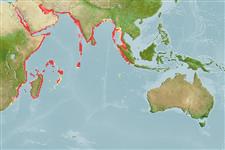Common names from other countries
>
Eupercaria/misc (Various families in series Eupercaria) >
Nemipteridae (Threadfin breams, Whiptail breams)
Etymology: Nemipterus: Greek, nema, -atos = filament + Greek, pteron = wing, fin (Ref. 45335).
More on author: Valenciennes.
Environment: milieu / climate zone / depth range / distribution range
Ecologia
marinhas demersal; não migratória; intervalo de profundidade 18 - 100 m (Ref. 30573). Tropical; 31°N - 30°S, 31°E - 103°E (Ref. 3810)
Indian Ocean: Red Sea, Persian Gulf, east Africa south to Delagoa Bay in Mozambique, Mauritius, Seychelles, Madagascar, Arabian Sea, Sri Lanka, Bay of Bengal, Andaman Sea, and Strait of Malacca. This species has generally been reported under the name Nemipteus delagoae or Nemipterus bleekeri.
Tamanho / Peso / Idade
Maturity: Lm ? range ? - ? cm
Max length : 30.0 cm TL macho/indeterminado; (Ref. 30573); common length : 25.0 cm TL macho/indeterminado; (Ref. 5450)
Espinhos dorsais (total) : 10; Raios dorsais moles (total) : 9; Espinhos anais: 3; Raios anais moles: 7. Suborbital spine absent. Preopercle with 3 transverse scale rows. Pectoral fins moderately long, reaching to or just behind anus. Pelvic fins long, reaching to or just beyond level of origin of anal fin. A line drawn up from posterior edge of suborbital reaching the dorsal profile about 3 to 5 scales before origin of dorsal fin. Scale rows on body below lateral line upward-curved anteriorly. Axillary scale present. Color: Upper body pinkish, silvery below. Snout with 2 indistinct stripes.
Found on sand or mud bottoms (Ref. 30573). Feeds mainly on crustaceans, cephalopods (Loligo), small fishes and polychaetes.
Life cycle and mating behavior
Maturities | Reprodução | Spawnings | Egg(s) | Fecundities | Larvas
Russell, B.C., 1990. FAO Species Catalogue. Vol. 12. Nemipterid fishes of the world. (Threadfin breams, whiptail breams, monocle breams, dwarf monocle breams, and coral breams). Family Nemipteridae. An annotated and illustrated catalogue of nemipterid species known to date. FAO Fish. Synop. 125(12):149p. Rome: FAO. (Ref. 3810)
Categoria na Lista Vermelha da IUCN (Ref. 130435)
CITES (Ref. 128078)
Not Evaluated
Ameaça para o homem
Harmless
Utilização humana
Pescarias: pouco comercial
Ferramentas
Relatórios especiais
Descarregue XML
Fontes da internet
Estimates based on models
Preferred temperature (Ref.
115969): 22.8 - 28.7, mean 26.1 (based on 168 cells).
Phylogenetic diversity index (Ref.
82804): PD
50 = 0.5000 [Uniqueness, from 0.5 = low to 2.0 = high].
Bayesian length-weight: a=0.01259 (0.01037 - 0.01528), b=2.96 (2.92 - 3.00), in cm Total Length, based on LWR estimates for this species (Ref.
93245).
Nível Trófico (Ref.
69278): 3.9 ±0.49 se; based on food items.
Resiliência (Ref.
120179): Elevada, tempo mínimo de duplicação da população menor que 15 meses (K=0.4-0.8).
Fishing Vulnerability (Ref.
59153): Low to moderate vulnerability (28 of 100).
